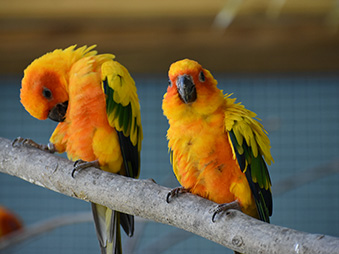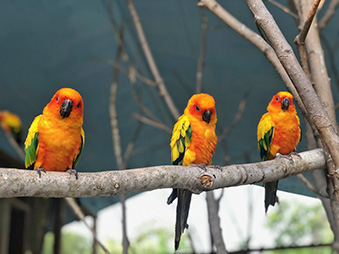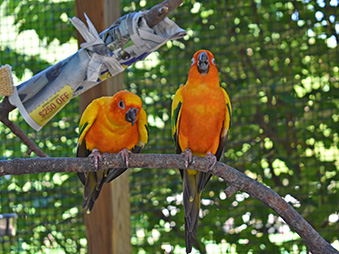Aratinga solstitialis | Sun Conure or Sun Parakeet
Names:
- Male: Biscuit, Churro, Paczki, Pancake, Pumpernickel, Toast, and Tortilla
- Female: Brioche, Challah, Ciabatta, Danish, and Flapjack



Meet the Flock
Say hello to our vibrant Sun Conures, residents of the aviary inside the Outback Habitat! With personalities as colorful as their feathers, these lively parrots are both crowd favorites and vital ambassadors for a species facing significant challenges in the wild.
Tropical Rainbows with Wings
Native to the northeastern forests of South America—including Brazil, Guyana, Venezuela, and Suriname—Sun Conures are among the most strikingly colored birds in the world. Their vivid yellow and orange bodies with green-tipped wings help them blend into the dappled light of tropical forests and savannah edges.
Males and females look nearly identical, making it hard to tell them apart. While females tend to have slightly shorter tails and males may appear brighter around the face and abdomen, these differences aren’t reliable for distinguishing sex.
Flock Life: Loud, Loyal, and Social
Highly social and vocal, Sun Conures live in flocks that typically range from 3 to 15 individuals—though gatherings of 20 to 30 aren’t uncommon. They rely on high-pitched calls to stay connected and alert each other to danger. These calls, while beautiful in the wild, can reach volumes comparable to a vacuum cleaner or jackhammer—one reason they don’t make ideal pets (more on that later).
Family First
Sun Conures are typically monogamous, forming lifelong pair bonds. Mated pairs can often be seen feeding and grooming one another, and they rarely stray from their flock. During breeding season, females incubate the eggs—usually 3 to 5 per clutch—while males stay close to the nest to protect and support them. Chicks are born altricial: blind, featherless, and completely dependent on their parents.
At the zoo, our Sun Conure flock includes both males and females of various ages, living alongside other bird species. Their diet mirrors what they’d eat in the wild: a mix of specialized parrot chow, fresh fruits and vegetables, grains, beans, seeds, and nuts.
Nature’s Gardeners
In their native habitat, Sun Conures play an important ecological role as seed dispersers. By consuming fruit and excreting seeds in new locations, they help maintain the health and diversity of tropical forests. However, in agricultural areas, they’re sometimes seen as pests due to crop damage.
Their movement patterns are tied to food availability. Some populations are nomadic, traveling long distances in search of food, while others remain in one area year-round. One thing is consistent—you’ll likely hear a Sun Conure long before you see one, thanks to their noisy flight calls. Once they’ve found a good feeding spot, they quiet down—after all, it’s not polite to talk with your beak full!
Fact Sheet
Taxonomy
Genus: Aratinga | Species: solstitialis |
Kingdom: Animalia | Phylum: Chordata | Class: Aves | Order: Psittaciformes | Family: Psittacidae |
Favorite Enrichment Type
Thick pieces of cardboard, and newspaper, hanging metal measuring cups, and parrot toys.
Life Span
- In the Wild: (Unknown)
- In Human Care: 15 to 30 years
Diet
- In the Wild: There is very little scientific information about what these birds eat in the wild. Best guess currently are seeds of fruits/berries, nuts, blossoms, buds, fruit pits, wind-dispersed seeds, insects, and agricultural crops.
- At the Zoo: A specialized parrot diet along with seeds, grains, beans, nuts, and fresh produce.
Geographic Range
Northeastern South America (Brazil, Guyana, and parts of Venezuela and Suriname).
Habitat
Tropical habitats, rainforests, scrub forest, and savannah/grasslands.
Status: Endangered
Conservation
Sun Conures are classified as Endangered, with wild populations declining rapidly. Their two biggest threats are:
- Habitat loss due to deforestation and agricultural expansion.
- Illegal capture for the pet trade.
These pressures have made wild sightings increasingly rare. Conservation efforts now focus on habitat protection, stricter anti-trafficking laws, and education campaigns that discourage the keeping of wild-caught birds.
Why Sun Conures Don’t Belong in Your Living Room
With their dazzling colors and affectionate nature, it’s easy to see why people are tempted to keep Sun Conures as pets. But behind the charm lies a serious commitment—often more than most people realize.
Here’s why they’re not good pets for most people:
- They’re incredibly loud – Their calls are designed to travel across forests, not apartments.
- They’re highly intelligent – Without daily mental and physical stimulation, they can become stressed, aggressive, or destructive.
- They form deep bonds – Loneliness and neglect can lead to severe emotional distress and self-harm, such as feather plucking.
- They live up to 30 years – Caring for a Sun Conure is a multi-decade responsibility.
- They’re a major reason the species is endangered – Demand from the pet trade has fueled illegal trafficking, devastating wild populations.
If you love parrots and are considering bringing one into your life, adopt from a reputable bird rescue and never purchase wild-caught birds. For most of us, the best way to show our love is by protecting them in the wild.
Learn more through the Not-a-Pet campaign.
Admire From Afar, Protect for the Future
Whether they’re mid-flight, foraging for snacks, or calling out to one another from the treetops, Sun Conures remind us that conservation starts with education. Sometimes, the best way to love an animal is to let it live wild and free.
Support their future by visiting AZA-accredited zoos and aviaries, or by donating to organizations that protect tropical habitats and fight wildlife trafficking.
How to Find Us
Our cheerful flock lives in the aviary in The Outback Habitat, where you can watch them chatter, preen, and show off their vibrant feathers.
